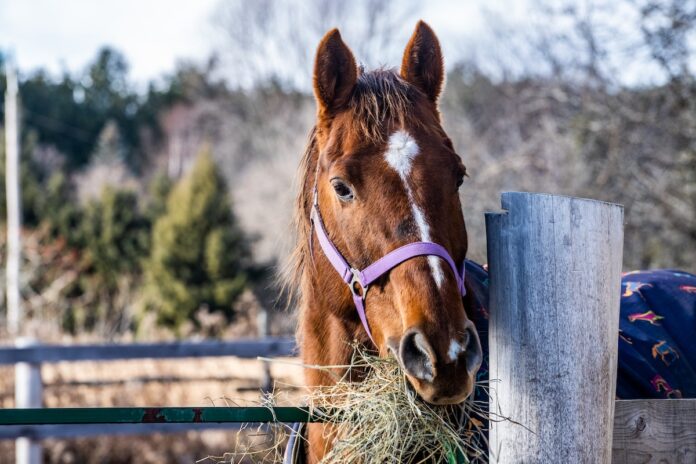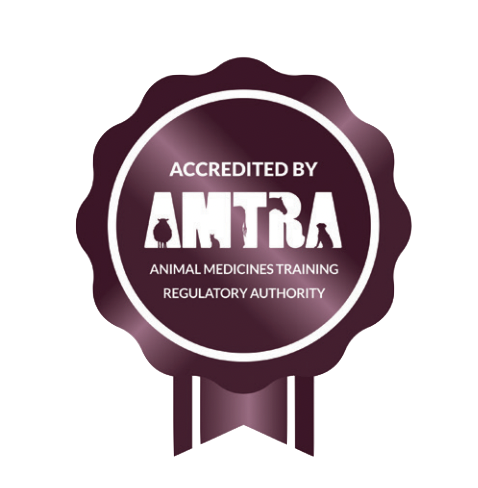
KNOW YOUR FEED TERMINOLOGY WITH THE SPILLERS JARGON-BUSTER
AMTRA is required by the Veterinary Medicines Regulations to ensure its RAMAs/SQPs undertake CPD. All RAMAs/SQPs must earn a certain number of CPD points in a given period of time in order to retain their qualification. RAMAs/SQPs who read this feature and submit correct answers to the questions below will receive two CPD points. For more about AMTRA and becoming a RAMA/SQP, visit www.amtra.org.uk
Becoming familiar with the science behind equine nutrition can help you advise and inform your customers with confidence and no better way to start than to get to grips with some of the common jargon. SPILLERS nutritionist Sarah Nelson talks us through the A to Z of feed terminology.
Antioxidant: Antioxidants are molecules which prevent the oxidation of molecules. Oxidation (iron turning rusty is an oxidative reaction) is a chemical reaction which, through the production of ‘free radicals’, can lead to cell damage. Examples of dietary antioxidants include vitamin E, vitamin A, vitamin C and selenium.
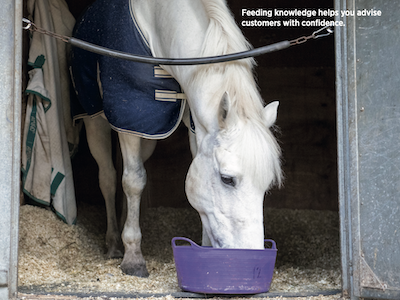
Ad lib (ad libitum): Ideally forage should be fed ‘ad lib’ (as much as the horse will eat). Although a very commonly used term, owners are sometimes confused as to what it means.
Ash: This one often causes confusion when it’s spotted on the feed label! Although it sounds like something you might find in your fireplace, it represents the mineral content of the feed.
Amino acids: Amino acids are the building blocks of protein; there are 21 in total, 9 of which must be supplied by the diet and are known as essential amino acids. Proteins are broken down to amino acids during the processes of digestion.
Biotin: Biotin is a water-soluble B vitamin. It is synthesised by the bacteria in the hindgut so it often doesn’t need to be supplied in the diet but, when fed at high levels it has been shown to improve hoof health and growth.
Body condition scoring: Body condition scoring is a practical method of assessing body fat by eye and by touch. Several areas where fat is commonly laid down are scored using a numerical grading system, most commonly a 1-9 or 0-5 scale. We recommend using the 1-9 scale but whichever system is used, the most important thing is to apply it consistently.
Belly girth: Measured around the widest point of the trunk (belly), belly-girth can be a very sensitive indicator of generalised fat loss in response to changes in diet. This perhaps makes it one of the most useful weight monitoring tools in overweight horses and ponies.
Calorie: A calorie is a unit of energy. Nutritionists often use the term ‘calories’ because it is one we all associate with bodyweight; but in horse feed we generally describe energy as digestible energy (DE) and use mega-joules as the unit (MJ). 1 MJ is equivalent to 239kcal about the same energy as a Mars bar.
Complementary feed: Is a feed that needs to be combined with other feeds in order to provide a complete balanced diet; for example, a competition mix needs to be fed alongside hay, haylage or grass and can’t be fed on its own.
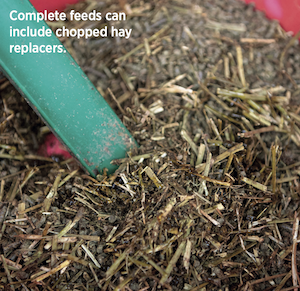
Complete feed: Is a feed that can be fed, as the name suggests, as the complete diet not combined with anything else. A chopped hay replacer may be described as a complete diet.
Dry matter: Dry matter (DM) is the material remaining after all the moisture (water) has been removed. Different feed stuffs contain different amounts of moisture. For example, haylage contains 50-80% dry matter and 20-50% moisture; and hay approximately 85-90% dry matter and 10-15% moisture. As the water content doesn’t count towards forage intake, the DM content of hay and haylage is particularly important for horses fed restricted rations.
Electrolytes: Electrolytes are compounds that conduct electricity when in solution; they are involved in many essential processes including the transmission of nerve impulses, muscle contractions (including those that make your heart beat) and maintaining water balance. The main electrolytes lost in sweat are sodium, potassium and chloride.
Fructans: You have probably heard of fructans in association with laminitis. The exact link to laminitis is unclear but it is thought they may be involved in triggering laminitis in grazing horses and ponies. Fructans are long chains of fructose often linked to sucrose and are the storage form of sugar (energy) in the majority of UK grasses. Horses cannot digest fructans in the small intestine, so instead they are rapidly fermented in the hindgut.
FOS or fructo-oligosaccharide: FOS shouldn’t be confused with grass fructan as the chemical structure is quite different, although both are chains of fructose. FOS is used in small amounts in feed and in some digestive supplements as a prebiotic, supplying a preferred energy source for ‘good’ bacteria.
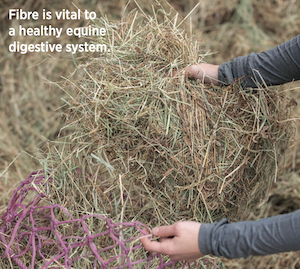
Fibre: Fibre is a structural carbohydrate that is vital to keep a horse’s digestive system healthy. Forage (or a suitable forage replacer) should be the main source of fibre and in the large majority of cases, should not be restricted to less than 1.5% of current bodyweight (dry matter) per day, even for those that are in hard work or are overweight.
Glucosamine: Glucosamine is an amino sugar and is known as a ‘hero’ ingredient when it comes to supporting joint health. Glucosamine is a chondro-protective agent and is thought to support proteoglycan synthesis and reduce cartilage degradation.
Heart girth: Measured as the horse/pony breathes out by passing a tape measure immediately behind the base of the withers and the elbows.
Hindgut: A term used to refer to the large intestine. The large intestine or ‘hindgut’ is the ‘powerhouse’ of the digestive system and is made up of the caecum, large colon and small colon.
International unit (IU): IU is the unit used to measure some vitamins including vitamin E. Vitamins can be added into a product in different forms. The unit IU allows us to compare these by measuring the biological activity of the vitamin within the horse rather than the quantity added into the feed i.e. If two different forms of a vitamin at different quantities illicit the same amount of biological activity in the horse, then they will contain the same number of IUs.
Jejunum: The small intestine is made of three sections. The middle section is the jejunum that extends from the duodenum (first section) and links to the ileum (third section).
Kg (kilogram): A unit used to measure weight. 1kg = 2.2lbs.
Lysine: Lysine is an essential amino acid and is, in fact, the first limiting - which means it is the one most likely to be deficient in the diet. It is also important in determining the rate of protein synthesis – the rate at which other amino acids can be utilised is dependent on lysine requirements being met.
Magnesium: Magnesium is a macro-mineral which means it is required in relatively large amounts in the diet. Most magnesium in the body is stored in the skeleton with the remainder found in muscles, soft tissues and in bodily fluids, helping to maintain fluid balance. Magnesium deficiencies are rare but can be associated with impaired muscle and nerve function.
Micro and macro minerals: There are two types of minerals: macro minerals, needed in relatively large quantities (grams per day (g/day)); and micro minerals or trace elements, needed in tiny quantities (frequently measured in milligrams per day (mg/day).
Non-structural carbohydrates (NSC): Carbohydrates are split into two groups depending on their chemical structure. Non-structural includes water-soluble carbohydrates plus starch.
Omega-3 fatty acids: Omega-3 fatty acids are fats typically found in plant and marine oils. Although not extensively researched in the horse, omega-3 oils are thought to have some health benefits in humans including supporting the immune and cardiovascular systems.
Probiotic: When you hear the word ‘probiotic’ you may think of the live bacteria in well-known yoghurt drinks. Live bacteria are not licensed for use in horses the UK (or the EU) but live yeast may help to maintain a more stable pH in the hindgut and improve fibre digestibility.
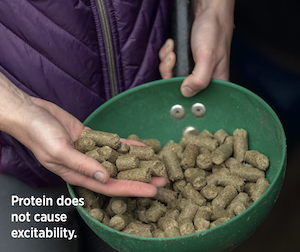
Prebiotic: Prebotics are non-digestible ingredients (typically high in fibre) aimed at supporting the health and proliferation of ‘good bacteria’ in the gut. FOS and MOS (mannan-oligosaccharides) are examples of prebiotics.
Protein: Proteins are compounds that consist of a chain or sequence of amino acids. Protein is needed in order to synthesise enzymes, immune cells and cartilage and to help build and repair muscle. Contrary to popular belief, protein does not cause excitability or swelling in legs.
Quidding: Quidding is the term used when partially chewed food is dropped from the mouth. This often occurs in older horses when their molar teeth become worn.
Rump width: Measured from the point of one hip to the point of the other.
Selenium: Selenium is a trace element required in very small amounts in the diet. It works closely with vitamin E within the body’s antioxidant defence system. It can be toxic if fed at high levels so care must be taken if feeding supplements.
Sugar Beet: Sugar beet is a root vegetable, similar to a swede or turnip. The sugar beet pulp fed to horses is what is left at the end of the sugar extraction process which produces the sugar we put in our tea. Sugar beet can be an excellent source of highly digestible fibre and a valuable source of energy (calories). In fact, sugar beet is significantly more digestible than hay and contains a similar level of energy (calories) to cereal grains and conditioning feeds which is why it is often referred to as a ‘super fibre’.
Threonine: This is an essential amino acid. It is thought to be the second limiting one in the horse, especially for growth, which means it is important for determining the overall rate of protein synthesis.
Ulcer: Gastric ulcers can be found in oesophagus, the upper (non-glandular) and lower (glandular) regions of the stomach and the first section of the small intestine. Most ulcers are found in the non-glandular region and are likely to be caused by exposure of the stomach lining to gastric acid.
Volatile fatty acids (VFAs): Volatile fatty acids are produced in the hindgut of the horse by the bacteria present there and are the end product of fibre fermentation. VFAs are used by the body as energy.
Vitamin A (or retinol): Vitamin A is a fat- soluble vitamin essential for immunity, cell differentiation, reproduction and vision. Vitamin A can be converted from beta carotene which is found in grass.
Vitamin C: Vitamin C is a water-soluble vitamin and an important antioxidant. It’s not usually required in the diet of horses as they can make it themselves from glucose in their liver, but there are times when supplementation may be of benefit, particularly in times of stress and illness. Research has also shown that high levels of vitamin C can support lung health.
Vitamin D: Vitamin D is a fat-soluble vitamin sometimes called the ‘sunshine vitamin’ as it is synthesised in the skin in the presence of UV light. This is why horses that are stabled or rugged for long periods may need additional supplementation. It is important for bone health.
Vitamin E: Vitamin E is a fat-soluble vitamin and plays a major role in the body’s anti- oxidant defence system alongside vitamin C and selenium.
Water-soluble carbohydrate (WSC): WSC refers to carbohydrates that are soluble in water and includes the approximate sum of simple sugars plus fructans.
Water: Water is the most essential component of a horse’s diet. Water is present in every cell in the body and is needed for the gut to work properly therefore horses can’t survive without it. On average, horses at rest drink approximately 5L of water per 100kg of bodyweight (approximately 25L for a 500kg horse) but this varies according to many factors including environmental conditions, the type of diet they are fed and workload - a 500kg horse on an all-hay diet may drink 40 litres of water per day.
Xylan: This is a type of complex polysaccharide found in plant cell walls and is a component of dietary fibre.
Yeast (live): The live yeast strain saccharomyces cerevisiae is used in many feeds and supplements to help support digestive health.
Zinc: Zinc is a trace element that plays a major role in many enzymes throughout the body and is important for bone, immune, skin and hoof health.

ABOUT ETN’S RAMA/SQP FEATURES
ETN’s series of CPD features helps RAMAs (Registered Animal Medicines Advisors/SQPs) earn the CPD (continuing professional development) points they need. The features are accredited by AMTRA, and highlight some of the most important subject areas for RAMAs/ SQPs specialising in equine and companion animal medicine.
AMTRA is required by the Veterinary Medicines Regulations to ensure its RAMAs/SQPs undertake CPD. All RAMAs/SQPs must earn a certain number of CPD points in a given period of time in order to retain their qualification. RAMAs/SQPs who read this feature and submit correct answers to the questions below will receive two CPD points. For more about AMTRA and becoming a RAMA/SQP, visit www.amtra.org.uk
Horse eating hay photo by chris robert










